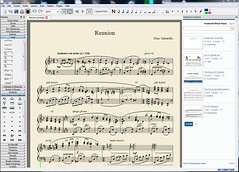Το MuseScore 1.2 κυκλοφόρησε
Με μεγάλη περηφάνια σας παρουσιάζουμε το MuseScore 1.2, την καλύτερη και πιο σταθερή έκδοση μέχρι σήμερα. Κατά τη διάρκεια των τελευταίων 8 μηνών, το MuseScore 1.1 έχει μεταφορτωθεί κοντά στις ένα εκατομμύριο φορές σε περισσότερες από 200 χώρες! Είναι μια φοβερή μαρτυρία πώς ένα ωραίο έργο λογισμικού ανοικτού κώδικα που οδηγείται από μια παθιασμένη ομάδα μουσικών και προγραμματιστών, επηρεάζει τη ζωή μουσικών απ' όλο τον κόσμο.
Μεταφορτώστε το MuseScore 1.2
Νέα
Το MuseScore 1.2 συμπεριλαμβάνει περίπου 100 διορθώσεις σφαλμάτων, κυρίως MusicXML import and export, notation, user interface, playback, styling and parts. With the much improved MusicXML support, you can now reliably import your sheet music collection from Sibelius or Finale into MuseScore.
A lot of effort went again into localizing MuseScore 1.2. The MuseJazz font has been extended tremendously for international alphabets. There are new translations for Estonian and Belarusian, and updates for the other 43 translations.
We also said goodbye to Moussorgsky’s Picture of an Exhibition, which has served us well as the MuseScore demo score for many years now. We found a worthy replacement in Marc Sabatella’s Reunion, which was composed specifically for MuseScore.
Last but not least, MuseScore Connect – which was introduced in version 1.1 – has been completely rebuilt. You can now search for sheet music shared by the community on musescore.com as well as search through your own collection and open scores directly into MuseScore. But this is just the start. From now on, MuseScore Connect will improve independently from the MuseScore releases.
Read more about 1.2 in the release notes.
The road to MuseScore 2.0
Version 1.2 was the last release in the 1.x series. From today on, we shift our focus entirely to MuseScore 2.0, and if you have a peek at the roadmap, you will understand that this release will be huge! To make this release rock, MuseScore and its developer team will need your help.
As the code contributor community of MuseScore is growing, we want a better way for developers to collaborate. We follow the move many other open source projects have made over the past years, by transferring the MuseScore code repository from SVN to GIT. So if you are building MuseScore, contributing patches or committing code, make sure you have read Nicolas’ post on the GIT migration.
If you are not into coding, but you rather like to help testing the newest features, the right place to start is the roadmap. Major new features such as linked parts, tablature, fret diagrams, figured bass, scroll view, repitch mode, custom palettes, quarter tone accidentals, more flexible time signatures, and more powerful text styling, will need serious testing. Your feedback is very welcome in the Technology Preview forum. Precise bug reports can be directly posted in the issue tracker.
In parallel with the feature testing, two more initiatives will need support: automated regression testing and the 2.0 handbook. More information on this will be posted as soon as GIT migration is finished.
Follow & support
Stay updated on all the MuseScore news via Facebook, Twitter, or the newsletter. If you would like to support MuseScore, you can always make a donation so we can grow the server that hosts the musescore.org site along with the growing MuseScore community. But above all, you can help MuseScore most by spreading the word and sharing MuseScore with your friends and family!
Now let's celebrate this release and listen to the new MuseScore demo song.
